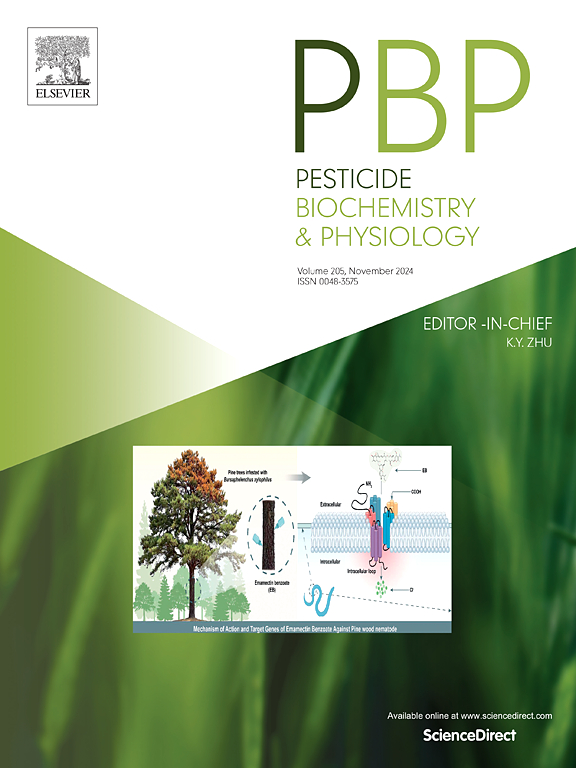Silica and mesoporous silica nanoparticles display effective insecticidal effect and augment plant defense responses
IF 4.2
1区 农林科学
Q2 BIOCHEMISTRY & MOLECULAR BIOLOGY
引用次数: 0
Abstract
The polyphagous insect pest, Spodoptera litura displays insecticide resistance that requires new control tactics. In this context, inorganic silica nanoparticles (SiNPs) and mesoporous silica nanoparticles (MSNPs) were studied for their insecticidal activity and their effects on the plant defense responses. The synthesized silica (SiNPs,160 nm size) and mesoporous silica (MSNPs,100 nm size) nanoparticles showed high insecticidal effect of against S. litura larvae with 73.0 and 80.0 % mortalities, respectively at low nanoparticles concentration (1 μg). Administration of NPs by feeding enhanced the larval gut uptake and caused a significant ∼14.9- to 12.7-fold reduction in lactate dehydrogenase activity for SiNPs and MSNPs, respectively. Efficient uptake of fluorescent NPs was illustrated in columnar larval gut cells. Feeding of SiNPs and MSNPs led to a significant reduction in larval weight (2.9- and 3.4-fold, respectively) due to their antifeedant effect which was positively correlated to larval mortalities. Both NPs exhibited negligible cytotoxicity in vitro. Furthermore, application of rhodamine B fluorescence-tagged NPs on soyabean leaves showed NPs presence on the leaf surfaces and were not internalized by the leaf. Moreover, the electromechanical plant responses to NPs application displayed increased localized signal durations (>2-fold). Additionally, SiNPs and MSNPs treatments significantly upregulated the 12-oxophytodienoate reductase plant jasmonic acid defense pathway gene expression (2.7- and 1.4-fold, respectively) that led to enhanced jasmonic acid contents. Application of SiNPs and MSNPs at low concentrations achieved insecticidal effect against S. litura and enhanced the plant defense responses against pest. Silica nanoparticles have potential in safe and effective management of S. litura.

二氧化硅和介孔二氧化硅纳米颗粒显示出有效的杀虫效果,增强了植物的防御反应
多食性害虫 Spodoptera litura 对杀虫剂具有抗药性,因此需要新的防治策略。在此背景下,研究了无机二氧化硅纳米颗粒(SiNPs)和介孔二氧化硅纳米颗粒(MSNPs)的杀虫活性及其对植物防御反应的影响。合成的二氧化硅纳米颗粒(SiNPs,160 nm)和介孔二氧化硅纳米颗粒(MSNPs,100 nm)在较低的纳米颗粒浓度(1 μg)条件下,分别对S. litura幼虫有较高的杀虫效果,死亡率分别为73.0%和80.0%。喂食纳米粒子可提高幼虫的肠道吸收,并使 SiNPs 和 MSNPs 的乳酸脱氢酶活性分别显著降低 14.9 至 12.7 倍。荧光 NPs 在柱状幼虫肠道细胞中被有效吸收。喂食 SiNPs 和 MSNPs 会导致幼虫体重显著下降(分别为 2.9 倍和 3.4 倍),这是因为它们具有反食性,而反食性与幼虫死亡率呈正相关。这两种 NPs 在体外的细胞毒性几乎可以忽略不计。此外,在大豆叶片上施用罗丹明 B 荧光标记的 NPs 表明,NPs 存在于叶片表面,不会被叶片内化。此外,植物对 NPs 应用的机电反应显示局部信号持续时间增加(2 倍)。此外,SiNPs 和 MSNPs 还能显著上调 12-oxophytodienoate 还原酶植物茉莉酸防御途径基因的表达(分别为 2.7 倍和 1.4 倍),从而提高茉莉酸含量。低浓度施用 SiNPs 和 MSNPs 可实现对 S. litura 的杀虫效果,并增强植物对害虫的防御反应。二氧化硅纳米粒子在安全有效地防治白蛾方面具有潜力。
本文章由计算机程序翻译,如有差异,请以英文原文为准。
求助全文
约1分钟内获得全文
求助全文
来源期刊
CiteScore
7.00
自引率
8.50%
发文量
238
审稿时长
4.2 months
期刊介绍:
Pesticide Biochemistry and Physiology publishes original scientific articles pertaining to the mode of action of plant protection agents such as insecticides, fungicides, herbicides, and similar compounds, including nonlethal pest control agents, biosynthesis of pheromones, hormones, and plant resistance agents. Manuscripts may include a biochemical, physiological, or molecular study for an understanding of comparative toxicology or selective toxicity of both target and nontarget organisms. Particular interest will be given to studies on the molecular biology of pest control, toxicology, and pesticide resistance.
Research Areas Emphasized Include the Biochemistry and Physiology of:
• Comparative toxicity
• Mode of action
• Pathophysiology
• Plant growth regulators
• Resistance
• Other effects of pesticides on both parasites and hosts.

 求助内容:
求助内容: 应助结果提醒方式:
应助结果提醒方式:


